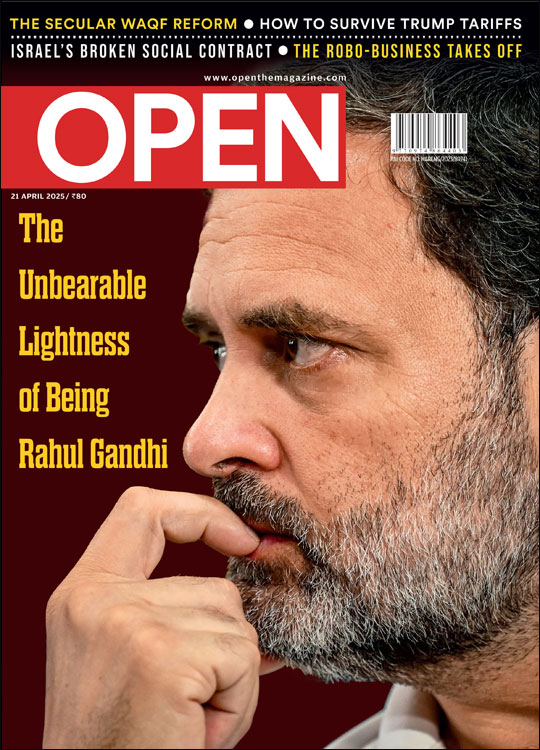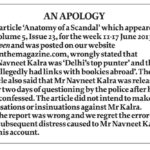Among the Believers
A temple for Narendra Modi and other shrines for politicians. A pilgrimage
 Omkar Khandekar
Omkar Khandekar
 Omkar Khandekar
Omkar Khandekar
 |
09 Apr, 2015
|
09 Apr, 2015
/wp-content/uploads/2016/01/18308.amongthebelievers1.jpg)
My first brush with political deification was on 17 November 2012, when Balasaheb Thackeray, the Shiv Sena supremo, succumbed to a cardiac arrest. At the time, I was a cub reporter working with a Mumbai-based newspaper. Over the next few days, I lost count of the number of times I heard people say, “He was like our God.”
Soon, a memorial came up on the playground used for the cremation of Thackeray’s body. Sena foot soldiers and sympathisers queued up with garlands and incense sticks and attended the bhajan programmes held every evening. An obituary in the party mouthpiece Saamna read: ‘God had sent the Shiv Sena leader for the welfare of the world… Perhaps, the gods found themselves in a crisis that he was recalled to the heavens.’
To me, it was never difficult to accept him as part of the Hindu pantheon, crowded as it may be with over 330 million gods and goddesses. In recent years, more were being added to the list anyway, to keep up with popular demand—the Aeroplane gurdwara in Jalandhar, the Bike temple in Rajasthan and the Dog temple in Karnataka, each of them catering to distinct kinds of mannat-asking devotees.
One of the earliest instances of the trend was the 1980s temple of the late MG Ramachandran in Tiruvallur, recalls social scientist Shiv Visvanathan. In the course of his academic career as an anthropologist, he has visited a number of such temples, including the one for MGR, the Tamil cinema superstar who played the role of Chief Minister off-screen for nearly 15 years. “On one occasion, MGR was having a cool drink and left it unfinished. The remains were sprinkled on the ground as holy water. Just like the woman who made the temple in his honour, there were others who thought of him as a holy man,” says Visvanathan. “In India, we often think of politicians as miracle-makers. To a certain extent, what we have is a form of hero worship. But it doesn’t last very long.”
Even among gods, there is a hierarchy. It can start with a stone with a dash of saffron, a sacred grove or the humble shrine of a holy man, and go all the way till the major-league players of Kedarnath and Tirupati. Some persist; others go out of circulation as soon as they stop drinking milk. Visvanathan says that the reason he finds it easy to see politicians find place among them is that the Hindu pantheon can be extraordinarily accommodating.
Others are less forgiving of the trend. Dalit-activist and political commentator Chandra Bhan Prasad sees a pattern in the personalities who have temples springing up in their name. “What I find strange is that nobody makes a temple for a politician who has fallen,” he says.
Prasad’s statement makes for a strong case. In 2008, when a Jodhpur-based priest proposed turning BJP leader Vasundhara Raje into Goddess Annapurna, she was the Chief Minister of Rajasthan. Two years later, a Vellore-based DMK worker declared his intention of exalting his party chief and then Chief Minister of Tamil Nadu M Karunanidhi to divine status after he was apparently impressed by his “pro-poor welfare measures”. Recently, Samajwadi Party leader Azam Khan went on record to say that his party head and three-time Uttar Pradesh Chief Minister Mulayam Singh Yadav, too, deserves a temple of his own.
“When you are making temples for such people, you stand to gain something in terms of public attention. It’s an exceptional form of greed,” says Prasad, “For instance, can you think of anyone wanting to make a temple for Manmohan Singh now?”
Prasad cites the example of a temple of ‘Goddess English’ that he is in the process of erecting in Uttar Pradesh. It is dedicated to English education as a tool of empowerment for the masses. He makes a pitch for building new temples in honour of ideas instead of personalities. Borrowing from a BJP slogan, he says, “If you are to build one for Narendra Modi, why not make it a ‘Sabka Saath, Sabka Vikaas’ temple?”
Oblivious to such arguments, by the second week of February, a certain Shankarbhai Manubhai Patel, resident of Kothariya village in Rajkot, had distributed hundreds of invitation cards announcing the inauguration of a Narendra Modi temple that he had ardently set up over the last few months. Forty-year-old Patel, a leader of the BJP’s youth wing (and a tea-seller as Modi once was), had been worshipping a portrait of the man who is now Prime Minster, at his residence for nearly nine years. For his planned temple, he had reportedly spent Rs 1.7 lakh on a statue made by a sculptor from Odisha.
It wasn’t long before news of this temple caught the imagination of the national media. On the morning of 12 February, when Patel switched on his TV set, he realised that his god had taken to Twitter to say he was ‘appalled’ to hear about the proposed temple in his honour. Patel was gobsmacked. The local collector issued directions for its demolition. What Patel and his associates had to say did not matter. The rubble was dumped in the backyard of Patel’s house and the idol stashed away.
Narendra Modi’s was not the first temple to a politican in India, nor was Patel the first to idolise the BJP leader so literally. That privilege goes to the Namo Namo Mandir in Uttar Pradesh where a member of the Vishva Hindu Parishad (VHP), a religious right-wing organisation with close links to India’s ruling party, has been worshipping an idol of Modi.
While a number of proposed temples for politicians either lie abandoned or are in various stages of completion, it is not too difficult to find instances of temples of Sonia Gandhi, Atal Bihari Vajpayee and Mahatma Gandhi.
In the last two weeks of March, I packed my bags, strapped on a camera, and went on a pilgrimage across five states to these shrines.
Deity: ATAL BIHARI VAJPAYEE, GWALIOR, MADHYA PRADESH
In his box-shaped sanctum, separated from the street by an eight-foot wall, Atal Bihari Vajpayee is a postcard sized photo- graph with a pack of incense sticks for company. In his vicinity is Hindi- mata, goddess of Hindi, housed in a temple of similar dimensions. The wreckage of a sedan forms the backdrop of the premises.
The Vajpayee temple is located at Satyanarayan tekri in Gwalior, Madhya Pradesh. It came up 15 years ago, ostensibly for the politician’s work for the cause of his mother tongue. A four-storied mall-like temple stands opposite Vajpayee’s, one that packs Lord Shiva, Vishnu and Krishna with their respective consorts within its walls. The keys to the Atal shrine lie with the priests of this temple. “We do it because he has been the leader of the nation. We think he is a Brahmin like us, a senior leader, a son of Gwalior,” says Pramod Mudgal. His family adopted the shrine years ago, ever since they found that the priests in charge of it were doing little for its upkeep.
While the locals of the tekri are familiar with the temple, I see no visitors or passersby take a moment for Vajpayee. As the blazing sun begins to weaken, sitting in the courtyard of Mudgal’s residence, we discuss the apathy of the people, including that of the founder of the temple Vijay Singh Chauhan, an advocate at the Gwalior High Court. “He comes once in several months. In the rains, he will come and go about a plantation drive. He does it every year, but somehow, no tree comes up,” Mudgal chuckles. “But photographs will be clicked and they will appear in the newspapers.”
The same drill is followed on 25 December, the birth anniversary of Vajpayee. Every evening, 14-year old Shubham Mudgal, a student of a local convent school, and his grandfather take turns to worship Vajpayee. Due to a tiff between the caretaker priests and the Mudgals, the gates are seldom open around puja time. Undeterred, Shubham, along with a cousin, scales the wall and places a diya and incense sticks in front of the deity. The irony isn’t easy to dodge: the torchbearer of Hindi being worshipped by a student of English.
I am to meet Chauhan the next day, at around noon. Two hours after our scheduled appointment, Chauhan saunters in wearing black robes, accompanied by a few clients and a friend clad in khaki. He orders tea and roasted gram for his patrons, and proceeds to rinse his mouth with tobacco. A few minutes later, he notices me tucked away in a corner.
Chauhan, 52, is president of the Uttar Bharatiya Abhibhashak Manch, an outfit that works— among other things—for the promotion of Hindi. Once a year, he hosts a small gathering within the Vajpayee temple premises, where invitees sing praises of Lord Rama through bhajans. He does not offer me any explanation for his adopted god lying ignored for the rest of the year, and instead, describes his ambitious plans of filing petitions to force the government to convert the temple into a tourist hotspot.
Like the temple’s de-facto priest, Chauhan says he doesn’t think of the leader as a god. “But a person who is a Prime Minister is not an ordinary man,” he says, “Any person who reaches that level is not ordinary. He has to be extraordinary.”
The structure and idol of the former Prime Minister cost Rs 5 lakh, the expenses borne by the Manch. But there were murmurs of protest about worshipping the idol of a living person, after which he claims to have immersed the idol in five rivers and journeyed from Gwalior to New Delhi on foot to gift it to the Prime Minister himself. “The whole country saw it. It was written about a lot,” he tells me. “A person out only for publicity wouldn’t work so hard.”
Deity: NARENDRA MODI, KAUSHAMBI, UTTAR PRADESH
After crossing the Chambal ravines, I wind up at Allahabad, and then take a bumpy ride by bus to Bhagwanpur, a village 60 km away. At a mobile store on its outskirts, I meet Chandrakant Dwivedi, a resident of the village. A jovial man in his early twenties, Dwivedi escorts me on his motorcycle to the door of Brijendranath Mishra, the priest of the local Namo Namo temple. Though acquainted with the family, Dwivedi shies away from greeting the Mishras.
“They don’t like me too much,” he tells me.
Mishra’s resemblance to Narendra Modi nearly makes me halt in my tracks. His beard is cropped in perfect imitation, as is the mat of his hair parting. He wears a saffron gamcha over a saffron kurta that ends where a loose white dhoti takes over. In the courtyard of his house stands a 300-year-old temple of Lord Shiva, known as the ‘Namo Namo temple’ ever since a statue of Narendra Modi came up in front of the Shivling.
“It is a Shiv temple,” Mishra insists, before citing one of his poems to buttress his argument: “Yeh Namo Namo mandir Shiv Shiv hai japta (This Namo Namo temple prays to Lord Shiva).”
Mishra sounds acutely aware that his theatrics had got him onto national television during last year’s General Election season. As I stroll around, he recites the numerous poems he has written as odes to Narendra Modi for the benefit of a visibly uninterested acquaintance, who buries his head in a newspaper. The poetry has familiar motifs: terror, Kashmir, the Ganga, the tricolour and soldiers posted on the frontlines. The bottomline: omnipotent Modi would save all.
After the failed Modi temple launch at Rajkot, a few television crews re- visited Mishra and asked him if he was worried. “I told them, I did not make a Modi temple. There is a Modi idol and he is praying to Lord Shiva as a devotee,” he says. It was a suggestion by Shiva himself, who appeared in a dream of his, he adds.
Towards the evening, Mishra calls upon some local VHP and BJP leaders to join him for prayers. Around six of us crowd into the temple’s sanctum sanctorum, and sit in a circle around the Shivling. I notice that the Modi idol, unlike the original incarnation, has been colour corrected to look more peachy, less wheatish. Decked in garlands of beads and plastic flowers, the idol wears a saffron waistcoat, a red cap and spectacles devoid of lenses.
Mishra bends on his haunches and lights a flame to begin his prayers to Lord Shiva. He leads from the front, blowing a conch and ringing a brass bell at suitable intervals. Five minutes into the Shiv aarti, the gathering arises and wraps it up with a resounding ‘Har Har Mahadev!’
And then it begins: a rendition of the Modi Chalisa, written and composed by Mishra himself. ‘Tere naam ka poore desh mein danka hai baaja, Om Jai Modi Raja,’ (‘Hail Modi, the ruler, he whose name has resounded across the country’) echo the voices within the chamber. They clap and hail the Lord and His disciple.
Modi worship, however, has done little to change the quality of life in Bhagwanpur. The village still reels under 12-hour power cuts, as has been the case for years. There is barely any trace of tarmac on the local roads. The place looks forlorn.
Every morning, before Mishra begins his prayers, his sister-in-law who stays next door enters the temple and places a diya before the idol. I ask her if there are any wishes she prays to Modi for fulfilment. “Just that, may the nation prosper, may we get better and proper schools, hospitals, may our houses be in better shape…”
Have any of those been realised?
“Not yet,” she says, “But we are still hopeful.”
Mishra isn’t too concerned about local infrastructure. His only aspiration is that the Prime Minister graces his temple and participates in a havan. Until then, he says, the rituals will continue.
The next day, a few hours before I leave for Allahabad, I stumble upon Dwivedi again. This time, he tells me why he thinks the priest does not like him. “When they set up the Modi temple, I told them, ‘You can’t make gods out of humans. If you had set up the idols of your parents instead, it would have been a much tasteful affair’,” Dwivedi says. “After that day, I fell out of their favour.”
Then it begins: a rendition of the Modi Chalisa: ‘Tere naam ka poore desh mein danka hai baaja, Om Jai Modi Raja’ (‘Hail Modi, the ruler whose name has resounded across the country’)
Deity: SONIA GANDHI, KARIMNAGAR, TELANGANA
For over a year now, Gauramma has been taking the same route from her house to the centre of Mallial village with a cleaning cloth and bucket of water. Around 9 am, she borrows the keys from a local shopkeeper and opens the wooden doors that reveal a marble idol of Sonia Gandhi, with high cheekbones and a double chin. After wiping the dust off the bust, it is the turn of the halo-shaped painting of Rajiv Gandhi that adorns the background.
Gauramma was born and raised in this village located 35 km away from Karimnagar, now in Telangana. She doesn’t know of the movement for statehood or Sonia Gandhi’s role in the formation of the new state. It’s only when I explain it to her, she says, that she understands why the temple is there. It’s something else, however, that makes her revere the Congress leader as a goddess. “It is because of her that I get a regular wage,” she says. A hundred rupees every month.
It takes more than a day to reach Karimnagar from Allahabad. Outside the train windows, the landscape changes from vast stretches of fields to unkempt forests once you cross Chattisgarh. After a night in the city, I board a bus to Mallial, where at noon I meet the local Congress mandal chief Rajeshwar Reddy at a tea stall a few feet away from the Sonia Gandhi temple.
By the second half of 2013, the Congress Working Committee, under Gandhi’s leadership, had decided that Telangana—then a part of Andhra Pradesh—would be granted statehood. Once the news spread, party workers in Karimnagar decided to build her a temple in gratitude. With the local body ruled by a Congress sarpanch, Reddy’s wife, it was a mere matter of time before government land was sanctioned for its construction. A custom-made marble bust that cost Rs 2.5 lakh was brought in from Rajasthan, and on 2 June 2014, the formation day of Telangana, the temple was thrown open to the public. Ponnam Prabhakar, the district’s Member of Parliament, also announ- ced a plan of building such temples in every assembly segment.
On my visit to the temple, I notice that except for the paintings of Rahul Gandhi and Indira Gandhi on the side walls, there’s little else in the enclosure. Reddy assures me that for Telangana’s people, Sonia Gandhi is akin to a goddess—only, not one you pray to. There is no priest at the temple, and while the doors are kept open for a couple of hours every evening, no rituals are performed.
“Nobody can do an aarti to a live human. That is not correct,” Reddy tells me.
I ask him if it would be okay after her demise.
“Then it will be compulsory,” he replies, “A must.”
Next, I meet Suresh Dumma, the artist who painted the portrait of Rahul Gandhi on one of the walls, at his shop right opposite the temple. “There is nothing temple-like about it,” he says. “The only people who come here are the local Congressmen.”
That evening, while talking to Prabhakar at his office in Karimnagar, I bring up the criticism I had heard. “It is our way of thanking her. We are not cheating anyone. Whenever we pass the village, we salute her and then go ahead,” he says.
Yet, I want to know if the temple has been put up in gratitude for Telangana, what explains the other Gandhi family members inside? What do they think Rahul Gandhi’s role was in the attainment of statehood?
“If Rahul Gandhi wasn’t in the loop, only Sonia Gandhi [alone] would not have taken the decision,” says Prabhakar. “He is our young leader.”
And Indira Gandhi?
“She is our Congress leader, she was our PM…”
That makes it seem like a monument for the Congress.
After evading a direct answer for some more time, Prabhakar finally says in exasperation, “We made the temple out of our own accord. We have the right to make a portrait of Rahul Gandhi. It doesn’t matter if people come to the temple or not… Yes, it has a photo of Nehru, of Rahul Gandhi, of Indira Gandhi. And they will stay.”
Deity: MAHATMA GANDHI, SAMBALPUR, ORISSA
IN ONE of the essays of The Mind of the Mahatma: Encyclopaedia of His Thoughts, Gandhi is cited as having written: ‘Our bodies are the real temples rather than buildings of stone. The best place for congregational worship is in the open with the sky as the canopy and mother earth below for the floor.’ When he wrote those lines, it had been years since Gandhi had visited a temple. He did not have anything against idolatry or places of religious worship, though, so long as it steered clear of superstition.
I have no way of knowing if these words escaped Abhimanyu Kumar in 1971, the year he became an MLA from Sambalpur district in Orissa and started work on deifying the Father of the Nation. Now 91 years old, Kumar is too weak to hear, speak or confirm as much. The temple he had built is a structure of stone, with its portico, shikhar and padlocked doors separating the deity from the masses. Responsibility for it has been passed over to his son Pramod Ranjan Kumar, a farmer and businessman.
At a distance of 10 km from the city, the Gandhi temple is located in Harijanpada, an all-Dalit colony that’s home to about 250 families. The former MLA was born here and was witness to numerous atrocities committed by ‘upper castes’. Back in those days, Dalits were banned from entering temples in several parts of India. In 1943, when Kumar was still in his teens, Gandhi held a general meeting at Sambalpur. According to Pramod, his father had attended it and was immensely inspired. It was then that he decided to build an all-caste, all-religion temple dedicated to Gandhi.
“Once the temple was completed in 1974, he appointed a priest from the Harijan community to conduct the rituals,” says Pramod Kumar. At the insistence of his elders, Kaliya Bag, a peon at a local women’s college, took up the responsibility. He had no prior experience in conducting rituals and so he got himself a how-to book on Hindu worship and taught himself how to be a priest. Four decades since his self-education, the 79-year- old still performs his duties.
Perhaps as a fitting tribute to the Mahatma, the people who keep him company in the inner sanctum transcend the barriers of caste, language and ideology. Next to the brass statue of the Mahatma, there hangs a portrait of Dr Babasaheb Ambedkar, Subhash Chandra Bose, Swami Vivekananda, even Indira Gandhi. At the feet of the Mahatma’s statue, there is the usual paraphernalia of flowers, kalash, bell and a copy of the Bhagwad Gita.
A soft-spoken Kumar solemnly nods when I tell him about my pilgrimage. Without offering any comments on the other temples, he says that he doesn’t see the Mahatma temple as an exception to the conventional idea of worship. “See, like there is Lord Krishna or Rama… nobody has seen them. We make temples in their name based on the Shastras and their lore. After a hundred years, there won’t be anyone left who has seen Gandhi. He, too, will then be considered a god,” he says.
That evening, Bag does not conduct the rituals. Taking his place is a dhoti-clad man in his mid-thirties. He seems inexperienced, and frequent- ly turns to look at Bag for approval, who stands on the front steps of the temple, guiding him on how to go about it. Throughout the hour, which also features a reading from the Bhagwad Gita, Bag continues to man the entrance, his hands folded in reverence. Then it is time for the recital of Raghupati Raghav Raja Ram, the hallmark of Gandhi’s prayer meetings.
As I watch Bag recite the bhajan under his breath, his voice drowned out by the enthusiastic children in the portico, I recall a conversation Kumar was having with a local earlier, informing him of the arrival of a newborn in Bag’s household.
“…so he won’t be coming to the temple today,” Kumar had said.
“Why?” I had asked.
It was time for a lesson in cultural intelligence: whenever a child is born in the family, restrictions are placed on all members of the family. Until the umbilical stump falls off, one cannot—among other things —visit a temple. In the words of Kumar: “For now, he has become an untouchable.”
About The Author
CURRENT ISSUE
The Unbearable Lightness of Being Rahul Gandhi
MOst Popular
3

/wp-content/uploads/2025/04/Cover-Congress.jpg)











More Columns
US Blinks On China Tariffs Madhavankutty Pillai
The Gifted Heir Sudeep Paul
SHAPING FUTURE IN THE INDIAN EDUCATION LANDSCAPE Open Avenues